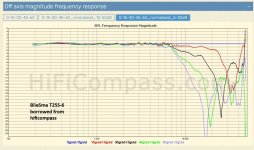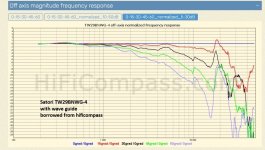Background – I’ve built speakers in the past but my most recent build was in 1999. So I am trying to read and catch up with current speaker building trends.
A lot more attention is being paid to off-axis performance these days. I gather that consistent and as wide as possible directivity are said to give a more realistic sound. That said, I am seeing two different approaches to off axis in tweeters. I have borrowed a couple of normalized off-axis curves from hificompass.com to demonstrate. Many thanks to them for their fine measurements.
Some folks are trying to keep the widest directivity to as high a frequency as possible followed by a smooth narrowing at higher frequencies. An example of this is the BlieSma T25S-6 where there is no narrowing of the off-axis curves until about 6.5k Hz. Then it narrows linearly until a break-up in the 17k – 20k region.
Others prefer an early but smooth narrowing, often accomplished with a wave guide. An example of this philosophy is the Satori TW29BNWG-4 which uses a wave guide and starts narrowing about 1300 Hz. As it happens, hificompass.com offers 3D printer plans for a the BlieSma T25S-6 which changes the T25S-6 into something like the Satori.
My question is which kind of directivity pattern is preferred and why? If it’s just preference, what are the advantages and disadvantages of each.


Thanks.
A lot more attention is being paid to off-axis performance these days. I gather that consistent and as wide as possible directivity are said to give a more realistic sound. That said, I am seeing two different approaches to off axis in tweeters. I have borrowed a couple of normalized off-axis curves from hificompass.com to demonstrate. Many thanks to them for their fine measurements.
Some folks are trying to keep the widest directivity to as high a frequency as possible followed by a smooth narrowing at higher frequencies. An example of this is the BlieSma T25S-6 where there is no narrowing of the off-axis curves until about 6.5k Hz. Then it narrows linearly until a break-up in the 17k – 20k region.
Others prefer an early but smooth narrowing, often accomplished with a wave guide. An example of this philosophy is the Satori TW29BNWG-4 which uses a wave guide and starts narrowing about 1300 Hz. As it happens, hificompass.com offers 3D printer plans for a the BlieSma T25S-6 which changes the T25S-6 into something like the Satori.
My question is which kind of directivity pattern is preferred and why? If it’s just preference, what are the advantages and disadvantages of each.


Thanks.
The second one (Satori with waveguide) is better because directivity is not changing abruptly. Indirect (off-axis) sound is gradually similar, producing more natural in-room sound.
Imaging is susceptible to the nearby walls. A waveguided system helps there, but is more challenging to design.
It's mostly user preference, which is why you see all kinds of speakers with different performance for this aspect.
The room and listening distance also come into play. Deader rooms and closer listening positions tend to be less sensitive to directivity's influence.
In broad strokes, and at normal listening distances in typical rooms, speakers approaching omnidirectional characteristics often have wider and deeper soundstage at the expense of imaging focus. The converse applies to more directional speakers.
A consistent trend in directivity across the frequency range is often the goal of modern speakers though. For most speakers that's smoothly increasing directivity with increasing frequency, but again the slope of the line can vary widely even within this approach.
The room and listening distance also come into play. Deader rooms and closer listening positions tend to be less sensitive to directivity's influence.
In broad strokes, and at normal listening distances in typical rooms, speakers approaching omnidirectional characteristics often have wider and deeper soundstage at the expense of imaging focus. The converse applies to more directional speakers.
A consistent trend in directivity across the frequency range is often the goal of modern speakers though. For most speakers that's smoothly increasing directivity with increasing frequency, but again the slope of the line can vary widely even within this approach.
Last edited:
All of this is very interesting. Would the directivity target change for a monopole tweeter and an open baffle mid and woofer? It seems like the target would be the same.
As an aside, I just realized that the tweeter I have been listening to for 20+ years is a Dynaudio D28, a horn/wave guide soft dome. I guess I have an idea of what that sounds like.
As an aside, I just realized that the tweeter I have been listening to for 20+ years is a Dynaudio D28, a horn/wave guide soft dome. I guess I have an idea of what that sounds like.
how much distance from the side walls or listening position are too much close to favor an horned tweeters ?
Thanks
Thanks
a monopole tweeter and an open baffle mid and woofer
The target is often similar in that case. A waveguide monopole tweeter can be a decent directivity match for a dipole midrange if the cross point and other details are chosen carefully.
Some have gone to dipole in the tweeter section also and very small baffles to try to maintain the same directivity across the full range.
Some relevant discussions and examples here:
https://www.linkwitzlab.com/Constant_directivity_louds.htm
https://www.linkwitzlab.com/The_Magic/The_Magic.htm
https://musicanddesign.speakerdesign.net/Dipoles_and_open_baffles.html
https://musicanddesign.speakerdesign.net/naomain.html
I'm not sure that can be answered with a blanket recommendation without knowing more about the listener's preferences and room limitations. Designs like the Klipschorns are meant to go in the corner, and some people just aren't as concerned with imaging/soundstaging.too much close to favor an horned tweeters
But from a general speaker positioning standpoint, Linkwitz' 3 feet seems like a good recommendation for a typical untreated listening room. In my room, a bit more than that is still beneficial for soundstage depth though.
https://www.linkwitzlab.com/orion++.htm
"I have found in the past that speakers should be placed at least 3 feet from reflecting surfaces so that the delay is greater than 6 ms. This seems to insure that the reflection is no longer perceived as a property of the direct sound and coming from the speaker."
Last edited:
If you design your waveguide properly, you can go close to the walls. There is an advantage to this in effectively expanding the space to reduce the problem even further.how much distance from the side walls or listening position are too much close to favor an horned tweeters ?
Thanks
@mattstat
Sure. Anyway a loudspeaker should image well. I tipically listen to at 3 to 4 meters (sorry for the feets) with front of the speaker at >= 1 m from the side walls and >=1 m from the front wall. It works best in my damping living room. But my main is flat tweeter face plate mounted. I have not bad imaging nore good as itis too sensible to head horizontal moves according the material playback. But I have some venue fine details ambiance (which surely are there with controlled directivity as well)
Sure. Anyway a loudspeaker should image well. I tipically listen to at 3 to 4 meters (sorry for the feets) with front of the speaker at >= 1 m from the side walls and >=1 m from the front wall. It works best in my damping living room. But my main is flat tweeter face plate mounted. I have not bad imaging nore good as itis too sensible to head horizontal moves according the material playback. But I have some venue fine details ambiance (which surely are there with controlled directivity as well)
Thanks for the links and the words. I've gone through many of them but I need to go back and read them again. As I start to get my mind around it, I need to go back for a deeper understanding (hopefully).The target is often similar in that case. A waveguide monopole tweeter can be a decent directivity match for a dipole midrange if the cross point and other details are chosen carefully.
Some have gone to dipole in the tweeter section also and very small baffles to try to maintain the same directivity across the full range.
Some relevant discussions and examples here:
https://www.linkwitzlab.com/Constant_directivity_louds.htm
https://www.linkwitzlab.com/The_Magic/The_Magic.htm
https://musicanddesign.speakerdesign.net/Dipoles_and_open_baffles.html
https://musicanddesign.speakerdesign.net/naomain.html
My speakers are 1 meter from the front wall and close to 2 m from the side walls. My reverb curve is really smooth with an RT60 about 450 ms. I'm thinking that my room might allow a wider directivity, especially since the current thought is to cross the tweeter to an upper-mid 3 or 4" (75 or 100 mm), then to a 10 inch lower mid and subs to fill in below. A lot to think about.
This paper might interest you - it discusses improving sweet spot width:I have not bad imaging nore good as itis too sensible to head horizontal moves according the material playback.
Setup of Controlled-Directivity Waveguide Speakers
https://www.libinst.com/PublicArticles/Setup of WG Speakers.pdf
- Home
- Loudspeakers
- Multi-Way
- Tweeter off-axis patterns